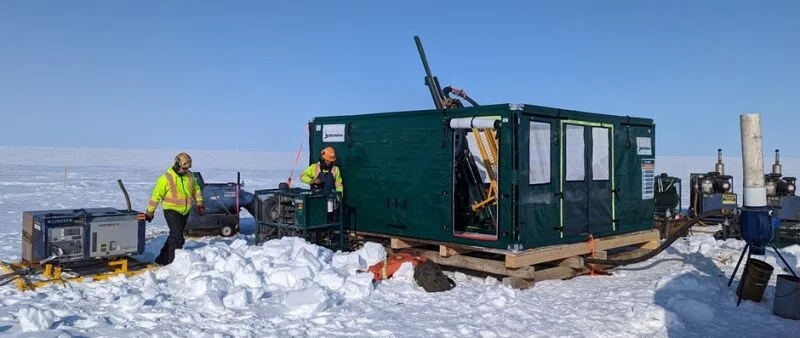Grades of the Strategic Metal Gallium Exceed 100 g/t in Some Cases!
As early as the end of October 2024, Cerro de Pasco Resources (CSE CDPR / FRA N8HP) had completed the first 40-hole drilling program on the polymetallic tailings deposit Quiulacocha. Now, they are once again presenting results for a portion of the more than 1,000 samples taken, where the silver grades are above initial expectations. Not to mention that Cerro de Pasco can also demonstrate increasingly higher grades of the strategically important metal gallium!
In total, the results of eight more drill holes from the northern part of the Quiulacocha dump, which mainly contains silver, zinc, and lead from open-pit mining of past decades, are presented today. All data represent the entire drill core length from the surface. The highlights:
- – Drill hole SPT27 intersected 21 meters (‘m’) grading 49 grams per tonne (‘g/t’) silver (‘Ag’), 1.47% zinc (‘Zn’), 0.68% lead (‘Pb’), and 35 g/t gallium (‘Ga’)
- including a 6 m interval grading 0.16% copper (‘Cu’) and 0.24 g/t gold (‘Au’)
– Hole SPT35 intersected 19 m grading 55 g/t Ag, 1.62% Zn, 0.68% Pb, and 40 g/t Ga - including a 3 m long section with 0.14% Cu and 0.15 g/t Au
– Hole SPT36 intersected 21 m with 50 g/t Ag, 1.30% Zn, 0.64% Pb, and 32 g/t Ga - including a 4-meter section with 0.12% Cu and 0.14 g/t Au
– Hole SPT39 intersected 22 m with 47 g/t Ag, 1.63% Zn, 0.86% Pb, and 50 g/t Ga - including a 5-meter section with 0.16% Cu and 0.20 g/t Au
– Hole SPT40 intersected 20 m with 55 g/t Ag, 1.63% Zn, 1.35% Pb, and 97 g/t Ga - including a 5-meter section with 0.22% Cu and 0.23 g/t Au
– Hole SPT1_6 intersected 17 m with 54 g/t Ag, 1.49% Zn, 0.95% Pb, and 60 g/t Ga
– Hole SPT12 intersected 27 m with 52 g/t Ag, 1.28% Zn, 1.30% Pb, and 110 g/t Ga - including a 9 m long section with 0.18% Cu and 0.12 g/t Au
– Hole SPT1_3 intersected 32 m with 52 g/t Ag, 1.18% Zn, 1.07% Pb, and 88 g/t Ga
– including a 16 m long section with 0.12% Cu and 0.06 g/t Au
As Cerro de Pasco Resources’ CEO Guy Goulet explains, silver has been consistently detected in all 32 drill holes analyzed so far from this area – and the average grade now exceeds 50 g/t of the precious metal. Furthermore, it can be observed that the concentration of lead and gallium continues to increase towards the south. Several samples yielded more than 1% lead and 100 g/t gallium. The gallium values in the southern part of the investigated area range between 50 and 110 g/t, almost double the average value of the northern section!
The consistent and increasing occurrence of gallium, a metal essential for advanced electronics and renewable energy technologies, significantly enhances the economic potential of the project. The importance of gallium has recently increased dramatically in response to China’s export restrictions to the USA and other countries. As a result, the gallium price has risen to new heights, underscoring the strategic importance of the metal in global supply chains. This geopolitical shift emphasizes the urgent need for secure and diversified gallium sources, so it can be said that Cerro de Pasco Resources has demonstrated excellent timing with its discovery.
Additionally, the company encountered broader layers of tailings containing copper, silver, and gold in the southern part of the area investigated by drilling. Significant zones of 9 and 16 meters in thickness, for example, showed more than 0.10% copper. Peak values of 0.47% copper, 0.56 g/t gold, and 58 g/t silver were measured.
With this, Cerro de Pasco has now demonstrated that the metal content continues consistently at depth and laterally over 1,000 meters of the drilled area. Additionally, the indicated iron contents suggest that pyrite is also continuously present in the deposit. Pyrite, approximately 50% of the tailings, could thus prove to be an important by-product for the company. Whether this is the case will be determined, among other things, by the subsequent metallurgical tests. These are intended not only to estimate the potential for pyrite recovery but also to estimate grades, by-products, and impurities.
Conclusion: Cerro de Pasco Resources’ Quiulacocha is a special case, as it is not a natural deposit but rather the tailings from decades of mining from one of Peru’s largest polymetallic mines. In the past, mineral grades that many companies would eagerly accept today were considered insufficiently profitable. This not only explains the high metal concentrations that Cerro de Pasco continues to drill, but also makes the anticipated extraction considerably easier – and thus cheaper – than in a conventional mine. In particular, gallium contents such as those demonstrated by the company are generally not observed even remotely in natural occurrences. We now wait to see what the final drilling results will bring and are then eager to learn about the metallurgy and the next steps!







